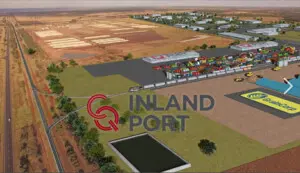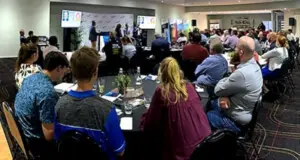A PhD top-up scholarship from CRC TiME allowed me to conduct a study exploring multi-stakeholder perspectives on mechanisms with which to manage a prospective transition from coal and transform regional economies. As part of this study, I visited the Central Highlands, Queensland, from 14 to 18 August 2023. I was hosted by the Central Highlands Development Corporation (CHDC) led by CEO Peter Dowling, who helped connect me with key stakeholders in the region. The week was fruitful as I was able to engage with and collect data from coal mining companies, regional governments, local businesses, and the CHDC. This data relates to coal mining and economic diversification in the energy transition context.

Image taken from https://app.remplan.com.au/centralhighlands/community/summary
The findings of my research will be available in due course; however, there were a few highlights of my visit to the region.
 I started the first day by talking to stakeholders in Emerald, which is the main town in the Central Highlands. I also drove to and spoke with stakeholders in Blackwater, one of the regional towns that is dependent on coal mining. With a size of Tasmania and population of 28,583, the Central Highlands is home to twelve operating coal mines, which employ 3,213 Central Highlands residents. Considering the indirect jobs and supplier businesses linked to the mines, the coal mining sector is considered to have been the main economic driver since the 1970s.
I started the first day by talking to stakeholders in Emerald, which is the main town in the Central Highlands. I also drove to and spoke with stakeholders in Blackwater, one of the regional towns that is dependent on coal mining. With a size of Tasmania and population of 28,583, the Central Highlands is home to twelve operating coal mines, which employ 3,213 Central Highlands residents. Considering the indirect jobs and supplier businesses linked to the mines, the coal mining sector is considered to have been the main economic driver since the 1970s.
 As part of my research enquiry, I drove around the region and visited businesses, agricultural land, and the mighty Fairbairn Dam – the state’s second biggest after the Burdekin Fall Dam. With a capacity to hold 1,301,000 ML of water, the Dam provides water for irrigation, industrial and urban use. Further north is Sapphire and Rubivale, where I observed gem cutting and trading centres, and people in caravans (some were so-called ‘brown nomads’, young nomadic families) fossicking.
As part of my research enquiry, I drove around the region and visited businesses, agricultural land, and the mighty Fairbairn Dam – the state’s second biggest after the Burdekin Fall Dam. With a capacity to hold 1,301,000 ML of water, the Dam provides water for irrigation, industrial and urban use. Further north is Sapphire and Rubivale, where I observed gem cutting and trading centres, and people in caravans (some were so-called ‘brown nomads’, young nomadic families) fossicking.

Image taken from cqinlandport.com.au
I also visited CQ Inland Port – which is a purpose built 240ha industrial estate zoned special industry at Yamala, 25km east of Emerald. The estate serves as a freight intermodal facility with direct access to Capricorn Highway and main western rail line. Among other functions, different crops including chickpeas, sorghum, cotton, and wheat are handled, stored, and transported across Australia and potentially overseas via Brisbane port. With growing interest in technological innovation in agribusiness and Agtech, and potential increase in commercialisation, this hub could draw-in regional economic activities and help sustain the regional economy during the prospective coal transition.
The Central Highlands is just one of many Australian coal regions that might be facing a significant economic impact as the transition from coal materialises. For many of the locals, agriculture and perhaps tourism may provide an economic source to fall back on, but they undoubtedly expect a massive impact if the transition period is not used to address some of the gaps that could be created through declines in revenues and employment.
Perhaps not surprising is that the multi-stakeholders’ perceptions about coal mining and outlook on the prospective phase-out generally contrasts with that expressed at the national and international levels. As such, part of the main motivation for conducting this research is to engage with and understand the lived experiences of coal regions in Australia and their perspectives on what may lie ahead. As I navigate through research questions with my participants, I was able to thread through what existing and potentially new economic activities and capabilities might be developed to enable regional economies transition from coal.
 A pleasant coincidence and a bonus to my visit was my attendance in the annual Resources and Innovation Forum 2023, which is organised by CHDC. I am grateful to the CHDC for inviting me to this event, which brought together about 60 participants. Chaired by Councillor Kerry Hayes (Mayor of Central Highlands Regional Council), the Forum hosted informative presentations and panel discussion by Andrew Barger (Queensland Resources Council), Aaron Birkby (Tribe Global Ventures), and Ann Houston (Sojitz Blue). One of the key points made was that the transition from metallurgical coal will not be a speedy or smooth one, given the expected demand for their use in the manufacturing of steel, among others. Steel is a key input in all the known renewable energy technologies. Another point made was the importance of agriculture in regional Australia, despite the sector being overshadowed by mining.
A pleasant coincidence and a bonus to my visit was my attendance in the annual Resources and Innovation Forum 2023, which is organised by CHDC. I am grateful to the CHDC for inviting me to this event, which brought together about 60 participants. Chaired by Councillor Kerry Hayes (Mayor of Central Highlands Regional Council), the Forum hosted informative presentations and panel discussion by Andrew Barger (Queensland Resources Council), Aaron Birkby (Tribe Global Ventures), and Ann Houston (Sojitz Blue). One of the key points made was that the transition from metallurgical coal will not be a speedy or smooth one, given the expected demand for their use in the manufacturing of steel, among others. Steel is a key input in all the known renewable energy technologies. Another point made was the importance of agriculture in regional Australia, despite the sector being overshadowed by mining.
 Perhaps the best way to end this piece is with one critical message parted by all the presenters on the need for Australian regions to work collaboratively, rather than in competition, in the development of technology in agriculture, manufacturing, bioenergy, and other renewable energy. Technology development, if backed by proactive strategy and funding, is tipped to propel the country into clean production and prosperous future.
Perhaps the best way to end this piece is with one critical message parted by all the presenters on the need for Australian regions to work collaboratively, rather than in competition, in the development of technology in agriculture, manufacturing, bioenergy, and other renewable energy. Technology development, if backed by proactive strategy and funding, is tipped to propel the country into clean production and prosperous future.
–Fitsum S. Weldegiorgis, PhD candidate and CRC TiME HDR top-up scholarship recipient

